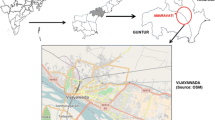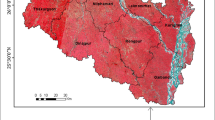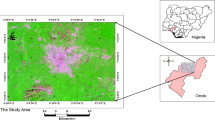Abstract
Urban expansion is a process of urban development as a result of population growth. Urban sprawl, known as unplanned and unrestricted urban expansion, is among the most important topics in urban studies. In recent decades, many cities around the world in both developing and developed countries have experienced urban expansion. Istanbul and Sydney are two of those cities encountering the urban expansion. Thus, in this study, the spatial and temporal pattern of urban expansion of the most urbanized districts of Istanbul (Arnavutköy) and Sydney (Hills Shire) was analyzed using multi-temporal remote sensing data. Initially, the Landsat images were classified to evaluate the land use/land cover (LULC) changes. The change detection analysis revealed that urban area of Arnavutköy district has increased about 669% from 1997 to 2017 and urban area of Hills Shire Local Government Area (LGA) increased by 78% between 1996 and 2018. The relationship of land surface temperature (LST) and urban areas extracted by recoding the LULC maps was also evaluated in different buffer zones. The results showed that with the increase in urban area extent, the LST has also increased. Then, Shannon’s entropy and spatial landscape metrics were used to analyze the district-based urban expansion. The results showed that both study areas expanded over the time but the main differences observed are that Arnavutköy has more fragmented and Hills Shire has a more compact urban growth process.














Similar content being viewed by others
Data availability
The datasets generated during the current study are available from the corresponding author on reasonable request.
References
Abdullahi, S., & Pradhan, B. (2017). Urban expansion and change detection analysis (pp. 155–170). Springer.
Abebe, G. A. (2013). “Quantifying urban growth pattern in developing countries using remote sensing and spatial metrics: a case study in Kampala, Uganda”, University of Twente.
Abir, F. A., & Saha R. (2021). “Assessment of land surface temperature and land cover variability during winter: a spatio-temporal analysis of Pabna municipality in Bangladesh.” Environmental Challenges, 100167.
Aburas, M. M., Ho, Y. M., Ramli, M. F., & Z. H. Ash’aari,. (2018). Monitoring and assessment of urban growth patterns using spatio-temporal built-up area analysis. Environmental Monitoring and Assessment, 190(3), 156.
Ahmad, A., & Quegan, S. (2012). Analysis of maximum likelihood classification on multispectral data. Applied Mathematical Sciences, 6(129), 6425–6436.
Akın, A., Sunar, F., & Berberoğlu, S. (2015). Urban change analysis and future growth of Istanbul. Environmental Monitoring and Assessment, 187(8), 506.
Akintunde, J. (2019). Spatial pattern of urban growth using remote sensing and landscape metrics. Journal of Geomatics, 13(1), 53.
Akyürek, D., Koç, Ö., Akbaba, E., & Sunar, F. (2018). “Land use/land cover change detection using multi-temporal satellite dataset: A case study in Istanbul new airport. ” Int. Arch. Photogramm. Remote Sens. Spat. Inf. Sci, 42, 17–22.
Al-Bilbisi, H. (2019). Spatial monitoring of urban expansion using satellite remote sensing images: A case study of Amman City, Jordan. Sustainability, 11(8), 2260.
Al-Sharif, A. A., Pradhan, B., Shafri, H. Z. M., & Mansor S. (2014). Quantitative analysis of urban sprawl in Tripoli using Pearson’s chi-square statistics and urban expansion intensity index. IOP Conference Series: Earth and Environmental Science, IOP Publishing.
Alsharif, A. A., Pradhan, B., Mansor, S., & Shafri, H. Z. M. (2015). Urban expansion assessment by using remotely sensed data and the relative Shannon entropy model in GIS: A case study of Tripoli, Libya. Theoretical and Empirical Researches in Urban Management, 10(1), 55–71.
Angel, S., Parent, J., Civco, D. L., Blei, A., & Potere, D. (2011). The dimensions of global urban expansion: Estimates and projections for all countries, 2000–2050. Progress in Planning, 75(2), 53–107.
Araya, Y. H., & Cabral, P. (2010). Analysis and modeling of urban land cover change in Setúbal and Sesimbra, Portugal. Remote Sensing, 2(6), 1549–1563.
Asokan, A., & Anitha, J. (2019). Change detection techniques for remote sensing applications: A survey. Earth Science Informatics, 12(2), 143–160.
Australia, I. (2018). “Future Cities: planning for our growing population.” Australian Government.
Barnes, K. B., Morgan, J. M., III., Roberge, M. C., & Lowe, S. (2001). Sprawl development: Its patterns, consequences, and measurement. Towson University, Towson, 1, 24.
Berberoglu, S., & Akin, A. (2009). Assessing different remote sensing techniques to detect land use/cover changes in the eastern Mediterranean. International Journal of Applied Earth Observation and Geoinformation, 11(1), 46–53.
Bharath, H., Chandan, M., Vinay, S., & Ramachandra, T. (2017). Modelling the growth of two rapidly urbanizing Indian cities. Journal of Geomatics, 11(12), 149–166.
Bhatta, B. (2009). Analysis of urban growth pattern using remote sensing and GIS: A case study of Kolkata, India. International Journal of Remote Sensing, 30(18), 4733–4746.
Bhatta, B., Saraswati, S., & Bandyopadhyay D. (2010a). “Quantifying the degree-of-freedom, degree-of-sprawl, and degree-of-goodness of urban growth from remote sensing data.” Applied Geography 30(1), 96–111.
Bhatta, B., S. Saraswati, S., & Bandyopadhyay, D. (2010b). “Urban sprawl measurement from remote sensing data.” Applied Geography, 30(4), 731–740.
Borana, S., Vaishnav, A., Yadav, S., & Parihar, S. (2020). Urban growth assessment using remote sensing, GIS and Shannon’s entropy model: a case study of Bhilwara city, Rajasthan. 2020 3rd International Conference on Emerging Technologies in Computer Engineering: Machine Learning and Internet of Things (ICETCE), IEEE.
Borana, S., & Yadav, S. (2017). Urban growth analysis using shannon’s entropy: A case study of Jodhpur city. International Journal of Advance Research in Computer Science and Management, 5, 50–57.
Chen, Y.-C., Chiu, H.-W., Su, Y.-F., Wu, Y.-C., & Cheng, K.-S. (2017). Does urbanization increase diurnal land surface temperature variation? Evidence and implications. Landscape and Urban Planning, 157, 247–258.
Çolak, E., & Sunar, F. (2020). “Evaluation of forest fire risk in the Mediterranean Turkish forests: a case study of Menderes region, Izmir.” International journal of disaster risk reduction, 45, 101479.
Deng, J. S., Wang, K., Hong, Y., & Qi, J. G. (2009). Spatio-temporal dynamics and evolution of land use change and landscape pattern in response to rapid urbanization. Landscape and Urban Planning, 92(3–4), 187–198.
Dhanaraj, K., & Angadi, D. P. (2020). “Land use land cover mapping and monitoring urban growth using remote sensing and GIS techniques in Mangaluru, India.” GeoJournal, 1–27.
Fonseka, H., Zhang, H., Sun, Y., Su, H., Lin, H., & Lin, Y. (2019). Urbanization and its impacts on land surface temperature in Colombo metropolitan area, Sri Lanka, from 1988 to 2016. Remote Sensing, 11(8), 957.
Fu, P., & Weng, Q. (2016). A time series analysis of urbanization induced land use and land cover change and its impact on land surface temperature with Landsat imagery. Remote Sensing of Environment, 175, 205–214.
Goldreich, Y. (2006). Ground and top of canopy layer urban heat island partitioning on an airborne image. Remote Sensing of Environment, 104(2), 247–255.
Gupta, S., Islam, S., & Hasan, M. M. (2018). Analysis of impervious land-cover expansion using remote sensing and GIS: A case study of Sylhet sadar upazila. Applied Geography, 98, 156–165.
Habibi, S., & Asadi, N. (2011). Causes, results and methods of controlling urban sprawl. Procedia Engineering, 21, 133–141.
Hashem, N., & Balakrishnan, P. (2015). Change analysis of land use/land cover and modelling urban growth in Greater Doha, Qatar. Annals of GIS, 21(3), 233–247.
Herold, M., Couclelis, H., & Clarke, K. C. (2005). The role of spatial metrics in the analysis and modeling of urban land use change. Computers, Environment and Urban Systems, 29(4), 369–399.
Jaeger, J. A., Bertiller, R., Schwick, C., & Kienast, F. (2010). Suitability criteria for measures of urban sprawl. Ecological Indicators, 10(2), 397–406.
Jat, M. K., Garg, P. K., & Khare, D. (2008). Monitoring and modelling of urban sprawl using remote sensing and GIS techniques. International Journal of Applied Earth Observation and Geoinformation, 10(1), 26–43.
Karimi, A., Pahlavani, P., & Bigdeli, B. (2017). “Land use analysis on land surface temperature in urban araes using geographically weighted regression and Landsat 8 imagery, a case study: Tehran, Iran.” International Archives of the Photogrammetry, Remote Sensing & Spatial Information Sciences 42.
Khwarahm, N. R., Qader, S., Ararat, K., & Al-Quraishi, A. M. F. (2020). “Predicting and mapping land cover/land use changes in Erbil/Iraq using CA-Markov synergy model.” Earth Science Informatics 1–14.
Kumar, J. A. V., Pathan, S., & Bhanderi, R. (2007). Spatio-temporal analysis for monitoring urban growth–a case study of Indore city. Journal of the Indian Society of Remote Sensing, 35(1), 11–20.
Lam, N. S.-N. (2008). Methodologies for mapping land cover/land use and its change. Advances in land remote sensing, Springer: 341–367.
Li, M., Zang, S., Zhang, B., Li, S., & Wu, C. (2014). A review of remote sensing image classification techniques: The role of spatio-contextual information. European Journal of Remote Sensing, 47(1), 389–411.
Li, X., Zhou, Y., Asrar, G. R., Imhoff, M., & Li, X. (2017). The surface urban heat island response to urban expansion: A panel analysis for the conterminous United States. Science of the Total Environment, 605, 426–435.
Lu, D., Li, G., Kuang, W., & Moran, E. (2014). Methods to extract impervious surface areas from satellite images. International Journal of Digital Earth, 7(2), 93–112.
Magidi, J., & Ahmed, F. (2019). Assessing urban sprawl using remote sensing and landscape metrics: A case study of City of Tshwane, South Africa (1984–2015). The Egyptian Journal of Remote Sensing and Space Science, 22(3), 335–346.
Masoumi, H. E., & Roque, D. (2015). Evaluation of urban sprawl speed and intensity based on international urbanization. Example from a Mexican city. Journal of Settlements and Spatial Planning, 6(1), 27–35.
McGarigal, K. (1995). “FRAGSTATS: spatial pattern analysis program for quantifying landscape structure”, US Department of Agriculture, Forest Service, Pacific Northwest Research Station.
McGarigal, K. (2002). “FRAGSTATS: spatial pattern analysis program for categorical maps. Computer software program produced by the authors at the University of Massachusetts, Amherst.” http://www.umass.edu/landeco/research/fragstats/fragstats.html
Mishra, S., Shrivastava, P., & Dhurvey, P. (2017). Change detection techniques in remote sensing: A review. International Journal of Wireless and Mobile Communication for Industrial Systems, 4(1), 1–8.
Mohammady, S., & Delavar, M. R. (2016). Urban sprawl assessment and modeling using landsat images and GIS. Modeling Earth Systems and Environment, 2(3), 155.
Mosammam, H. M., Nia, J. T., Khani, H., Teymouri, A., & Kazemi, M. (2017). Monitoring land use change and measuring urban sprawl based on its spatial forms: The case of Qom city. The Egyptian Journal of Remote Sensing and Space Science, 20(1), 103–116.
Nazarnia, N., Harding, C., & Jaeger, J. A. (2019). How suitable is entropy as a measure of urban sprawl? Landscape and Urban Planning, 184, 32–43.
Nong, D. H., Lepczyk, C. A., Miura, T., Fox J. M. (2018). “Quantifying urban growth patterns in Hanoi using landscape expansion modes and time series spatial metrics.” PloS one 13(5), e0196940.
Ozturk, D. (2017). Assessment of urban sprawl using Shannon’s entropy and fractal analysis: A case study of Atakum, Ilkadim and Canik (Samsun, Turkey). Journal of Environmental Engineering and Landscape Management, 25(3), 264–276.
Patino, J. E., & Duque, J. C. (2013). A review of regional science applications of satellite remote sensing in urban settings. Computers, Environment and Urban Systems, 37, 1–17.
Profillidis, V. A., & Botzoris, G. N. (2018). Modeling of transport demand: Analyzing, calculating, and forecasting transport demand. Elsevier.
Qin, Z., Karnieli, A., & Berliner, P. (2001). A mono-window algorithm for retrieving land surface temperature from Landsat TM data and its application to the Israel-Egypt border region. International Journal of Remote Sensing, 22(18), 3719–3746.
Rahman, M. T. (2016). Detection of land use/land cover changes and urban sprawl in Al-Khobar, Saudi Arabia: An analysis of multi-temporal remote sensing data. ISPRS International Journal of Geo-Information, 5(2), 15.
Reis, J. P., Silva, E. A., & Pinho, P. (2016). Spatial metrics to study urban patterns in growing and shrinking cities. Urban Geography, 37(2), 246–271.
Ren, P., Gan, S., Yuan, X., Zong, H., & Xie X. (2013). Spatial expansion and sprawl quantitative analysis of mountain city built-up area. Geo-informatics in resource management and sustainable ecosystem, Springer, 166–176.
Roy, B., & Kasemi, N. (2021). Monitoring urban growth dynamics using remote sensing and GIS techniques of Raiganj Urban Agglomeration, India. The Egyptian Journal of Remote Sensing and Space Science, 24(2), 221–230.
Sahana, M., Ahmed, R., & Sajjad, H. (2016). Analyzing land surface temperature distribution in response to land use/land cover change using split window algorithm and spectral radiance model in Sundarban Biosphere Reserve, India. Modeling Earth Systems and Environment, 2(2), 81.
Samal, D. R., & Gedam, S. S. (2015). Monitoring land use changes associated with urbanization: An object based image analysis approach. European Journal of Remote Sensing, 48(1), 85–99.
Sarvestani, M. S., Ibrahim, A. L., & Kanaroglou, P. (2011). Three decades of urban growth in the city of Shiraz, Iran: A remote sensing and geographic information systems application. Cities, 28(4), 320–329.
Shikary, C., & Rudra, S. (2021). Measuring urban land use change and sprawl using geospatial techniques: A study on Purulia Municipality, West Bengal, India. Journal of the Indian Society of Remote Sensing, 49(2), 433–448.
Sisodia, P. S., Tiwari, V., & Kumar A. (2014). Analysis of supervised maximum likelihood classification for remote sensing image. International conference on recent advances and innovations in engineering (ICRAIE-2014), IEEE.
Son, N.-T., & Thanh, B.-X. (2018). Decadal assessment of urban sprawl and its effects on local temperature using Landsat data in Cantho city, Vietnam. Sustainable Cities and Society, 36, 81–91.
Soriano, M., Hilvano, N., Garcia, R., Hao, A. J., Alegre, A., & Tiburan, C., Jr. (2019). Land use/land cover change detection and urban sprawl analysis in the Mount Makiling Forest Reserve watersheds and buffer zone, Philippines. Environments, 6(2), 9.
Stathopoulou, M., & Cartalis, C. (2007). Daytime urban heat islands from Landsat ETM+ and Corine land cover data: An application to major cities in Greece. Solar Energy, 81(3), 358–368.
Stone, B., Hess, J. J., & Frumkin, H. (2010). Urban form and extreme heat events: Are sprawling cities more vulnerable to climate change than compact cities? Environmental Health Perspectives, 118(10), 1425–1428.
Sunar, F. (1998). An analysis of changes in a multi-date data set: A case study in the Ikitelli area, Istanbul, Turkey. International Journal of Remote Sensing, 19(2), 225–235.
Tewolde, M. G., & Cabral, P. (2011). Urban sprawl analysis and modeling in Asmara, Eritrea. Remote Sensing, 3(10), 2148–2165.
USGS. (2019). “Landsat handbook.” from https://www.usgs.gov/core-science-systems/nli/landsat/landsat-8-data-users-handbook
Valor, E., & Caselles, V. (1996). Mapping land surface emissivity from NDVI: Application to European, African, and South American areas. Remote Sensing of Environment, 57(3), 167–184.
Voogt, J. A., & Oke, T. R. (2003). Thermal remote sensing of urban climates. Remote Sensing of Environment, 86(3), 370–384.
Weng, Q. (2001). A remote sensing? GIS evaluation of urban expansion and its impact on surface temperature in the Zhujiang Delta, China. International Journal of Remote Sensing, 22(10), 1999–2014.
World Population Review. (2020a). “World population review.” Retrieved April 10, 2020, from https://worldpopulationreview.com/
World Population Review. (2020b). “World population review.” Retrieved April 10, 2020, from https://worldpopulationreview.com/world-cities/istanbul-population
Wulder, M. A., Loveland, T. R., Roy, D. P., Crawford, C. J., Masek, J. G., Woodcock, C. E., Allen, R. G., Anderson, M. C., Belward, A. S., & Cohen, W. B. (2019). Current status of Landsat program, science, and applications. Remote Sensing of Environment, 225, 127–147.
Yeh, A.G.-O., & Li, X. (2001). Measurement and monitoring of urban sprawl in a rapidly growing region using entropy. Photogrammetric Engineering and Remote Sensing, 67(1), 83–90.
Yeh, C.-T., & Huang, S.-L. (2009). Investigating spatiotemporal patterns of landscape diversity in response to urbanization. Landscape and Urban Planning, 93(3–4), 151–162.
Yue, W., Liu, Y., & Fan, P. (2013). Measuring urban sprawl and its drivers in large Chinese cities: The case of Hangzhou. Land Use Policy, 31, 358–370.
Yulianto, F., Fitriana, H. L., & Sukowati, K. A. D. (2020). Integration of remote sensing, GIS, and Shannon’s entropy approach to conduct trend analysis of the dynamics change in urban/built-up areas in the Upper Citarum River Basin, West Java, Indonesia. Modeling Earth Systems and Environment, 6(1), 383–395.
Zhang, L., & Weng, Q. (2016). Annual dynamics of impervious surface in the Pearl River Delta, China, from 1988 to 2013, using time series Landsat imagery. ISPRS Journal of Photogrammetry and Remote Sensing, 113, 86–96.
Author information
Authors and Affiliations
Corresponding author
Ethics declarations
Conflict of interest
The authors declare no competing interests.
Additional information
Publisher's Note
Springer Nature remains neutral with regard to jurisdictional claims in published maps and institutional affiliations.
Rights and permissions
About this article
Cite this article
Azabdaftari, A., Sunar, F. District-based urban expansion monitoring using multitemporal satellite data: application in two mega cities. Environ Monit Assess 194, 335 (2022). https://doi.org/10.1007/s10661-022-09884-y
Received:
Accepted:
Published:
DOI: https://doi.org/10.1007/s10661-022-09884-y




